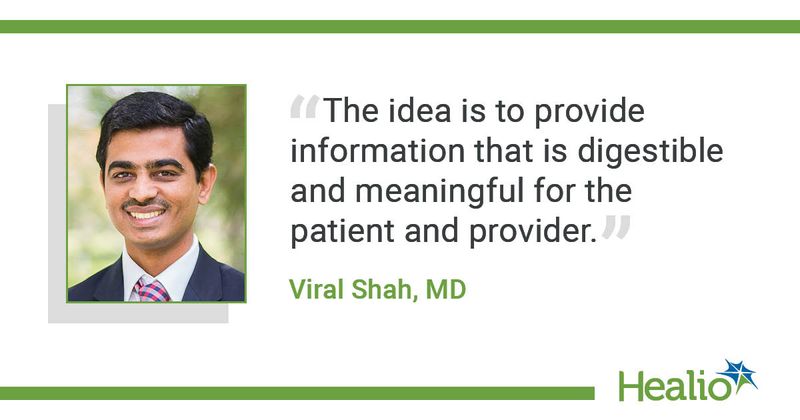Artificial pancreas ‘dashboard’ could ease diabetes data burden for patients, providers
Hybrid closed-loop insulin delivery systems have revolutionized care and lessened disease burden for people living with type 1 diabetes, and next-generation devices promise even more improvement.
Data demonstrate use of an artificial pancreas can improve time spent in the recommended glucose range and reduce hypoglycemia, in particular, nocturnal hypoglycemia. Yet analyzing patient data from such devices can be burdensome, with lengthy reports on a wide range of metrics, some of which may not help guide treatment decisions at all.

Healio spoke with Viral Shah, MD, associate professor of medicine and pediatrics at the Barbara Davis Center for Diabetes and the School of Medicine at the University of Colorado Anschutz Medical Campus, about the need to create a standardized, one-page data report for all hybrid closed-loop insulin delivery systems to increase device uptake and improve provider understanding. Shah and Satish K. Garg, MD, professor of medicine and pediatrics at the Barbara Davis Center for Diabetes, University of Colorado Denver, co-authored a review on the need for an artificial pancreas “dashboard” in a recent issue of Diabetes Technology & Therapeutics.
Why is standardization needed for artificial pancreas systems?
Shah: Here is a very specific example. If I have a patient with diabetes using the Medtronic 670G, and I download all the data, it is a 12-page report. If I do the same for a patient using Tandem Control IQ, it is a 20-page report. If I look at a report for the Omnipod [Insulet] with a Dexcom continuous glucose monitor, using Glooko, it becomes a 27-page report. Now, I am an endocrinologist specializing in type 1 diabetes, working specifically with hybrid closed-loop systems. I look at those 12-page or 27-page reports and I know where to find the information I may need. But think about that. That takes time. Many endocrinologists do not have time for this, let alone primary care doctors who do not have enough patients using hybrid closed-loop to know where to look on these reports.
Throughout medical school and residency programs, we all learn to use and read an ECG. There are different machines available that do this, but they all generate the same report. Every physician knows how to read an ECG. That kind of analogy has been used in the field of diabetes. During the last 8 to 10 years, with funding from the Helmsley Charitable Trust, the American Diabetes Association, and others, all these smart people came together and worked on standardizing glucose reporting. Today we call it an ambulatory glucose profile, or an AGP. Why can’t we use a similar approach for the hybrid closed-loop system? I discussed this idea with Dr. Garg to publish my opinion and suggestions on standardizing closed-loop system reporting in Diabetes Technology & Therapeutics, where he serves as the editor-in-chief.
You and Dr. Garg propose several components for inclusion in a standardized report. What are they, and how did you decide on them?
Shah: We are proposing seven components in an artificial pancreas “dashboard” that will provide information on the following: glucose metrics, hypoglycemia, insulin, user experience, hyperglycemia, glucose modal-day profile and insight. In the paper, we describe the optimal sampling duration for data download. For example, we recommend that hypoglycemia where the CGM glucose level is less than 70 mg/dL lasting for a minimum of 15 minutes should be reported, to avoid overreporting of hypoglycemic events due to sensor errors. We also recommended color coding on the report for ease of interpretation.
Ultimately, the idea is to provide information that is digestible and meaningful for the patient and provider so they can make therapeutic changes. We don’t want information that is not helpful at all. For example, with the Medtronic 670G system, you can only change two things: the carbohydrate ratio and insulin time. You cannot change, for example, basal rate. There is no point in including basal rate in the AP dashboard, which we cannot change to optimize glycemic control. What data makes the most sense for the clinician to integrate with glucose data?
We conducted a literature review regarding patient and provider perspectives on downloading and reporting preferences and incorporated standard reporting for glucose profiles.
Would the longer reports still serve a purpose?
Shah: Yes. We are not objecting to those longer reports. That information is really important. You need to provide those daily profiles. I do have some patients working part time, night-and-day jobs, and they need data on day vs. night. We understand the importance of those 27 pages. But how many patients will you see who require a full review of those 27 pages? I would venture to say less than 5% of patients. For the other 90%, they can be guided with a single page. That is what we want the device companies to think about, so we don’t have to scroll through pages and spend all this time.
Has there been any response from device manufacturers about this effort?
Shah: We hope to work with manufacturers. First, this is our opinion, and it is not evidence-based guidance. The best way to go about this is similar to how consensus was reached for AGP — bring the FDA, industry, patient organizations and professional societies to the table and go over this together. I am sure there are differences of opinion. For example, why seven components? Why not six components? Maybe eight? This type of debate is healthy. That brings ideas to the table and helps to generate consensus. We would like to involve industry and experts in the field, in the hope to build consensus in the future. One other important lesson from the past was that the efforts to build consensus for AGP started around 2012 and was not formalized until years later. Consensus building takes time.
Reference:
Shah VN, et al. Diabetes Technol Ther. 2020;doi:10.1089/dia.2020.0622.
For more information:
Viral Shah, MD, can be reached at viral.shah@cuanschutz.edu.
